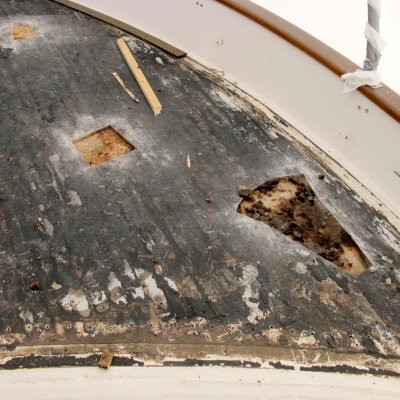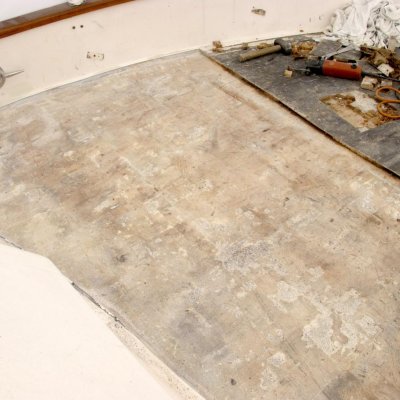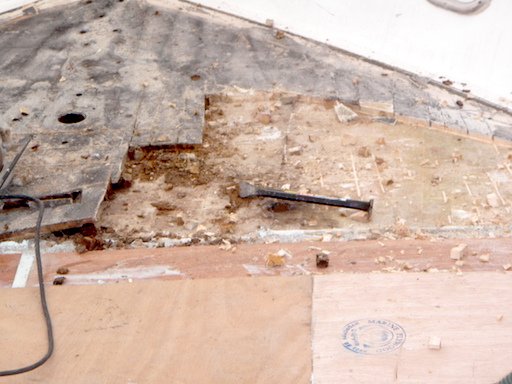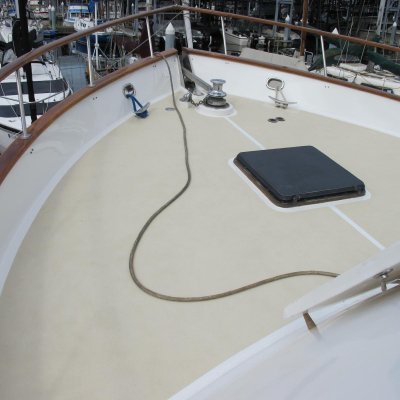stanfromhell
Senior Member
I have a 1981 Cheerman PT38 Europa which like most other Taiwan built trawlers, has water leaking thru the teak deck screw holes and into the wood core. The problem is bad in the area of the sampson post and seems to get better heading along the sidewalks to the steps near the front of the cabin where they are covered by the upper deck. The aft deck of the boat is also covered by the upper deck and appears to be OK.
i had planned to remove the teak on the foredeck, then cut away 12-18 inch wide strips out of the deck from the port to the starboard side, remove the wet core, install end grain balsa, cover, it with layers of matt so that it would have structural integrity then repeat the process moving aft untill no more wet core was found. I then planned to have a tradesman install the final layers of glass, gelcoat and nonskid for a professional looking job.
I spoke to three boat repair businesess who have done this type of work.
One said they would do the finishing for me as i requested and will be veiwing the boat within a week to rpovide an estimate.
Another said I had to do the work from the inside and should not do it from the outside but did not elaborate on why. I thought it was a strange way to do it and moved on with my search for someone else.
The next person (who has thirty years experiece doing fiberglass boat repairs) told me that if I removed strips as I described he would not do the finishing for me because I would be ruining the structural integrity of the boat and he didn't want his name associated with it.
His explanation was:
The hull and deck of this boat evidently is moulded, not screwed together. When it was built, the deck and cabin was placed upside down, the hull was placed on top of it and the two were glassed together. The assembly was then turned right side up and the build was continued. In effect my boat is made like a unibody car or van and if i were to cut a 1 foot strip of metal from one side of a cars roof to the other, then weld a new strip in, the doors would never close properly and the windows would leak becuase the body warped as soon as the strip was removed.
He is adamant that the same will happen to my boat.
His suggestion is to remove the teak strips and screws, plug the holes in the deck and tarp it very, very welll to keep the Vancouver winter rain out. Then remove the headliner and cabinetry, use a 3-4 inch holesaw to cut many holes thru the inner fiberglas deck but not into the core and keep moving back untill I no longer find moist core. If areas of totaly rotten core is found it must be replaced of course. Next l should place heaters in the cabin and run them for a few months untill the core is dry. Then do the necessary finishing and nonskid application.
This, he says, is the proper way to do it and he would not cut strips in the outside deck even if I offered him 10 K to do the job.
It doesn't make sense to me, but two out of three people want do fix the leaks from the inside of the boat so my question is....
How was your leaky trawler deck repaired?
i had planned to remove the teak on the foredeck, then cut away 12-18 inch wide strips out of the deck from the port to the starboard side, remove the wet core, install end grain balsa, cover, it with layers of matt so that it would have structural integrity then repeat the process moving aft untill no more wet core was found. I then planned to have a tradesman install the final layers of glass, gelcoat and nonskid for a professional looking job.
I spoke to three boat repair businesess who have done this type of work.
One said they would do the finishing for me as i requested and will be veiwing the boat within a week to rpovide an estimate.
Another said I had to do the work from the inside and should not do it from the outside but did not elaborate on why. I thought it was a strange way to do it and moved on with my search for someone else.
The next person (who has thirty years experiece doing fiberglass boat repairs) told me that if I removed strips as I described he would not do the finishing for me because I would be ruining the structural integrity of the boat and he didn't want his name associated with it.
His explanation was:
The hull and deck of this boat evidently is moulded, not screwed together. When it was built, the deck and cabin was placed upside down, the hull was placed on top of it and the two were glassed together. The assembly was then turned right side up and the build was continued. In effect my boat is made like a unibody car or van and if i were to cut a 1 foot strip of metal from one side of a cars roof to the other, then weld a new strip in, the doors would never close properly and the windows would leak becuase the body warped as soon as the strip was removed.
He is adamant that the same will happen to my boat.
His suggestion is to remove the teak strips and screws, plug the holes in the deck and tarp it very, very welll to keep the Vancouver winter rain out. Then remove the headliner and cabinetry, use a 3-4 inch holesaw to cut many holes thru the inner fiberglas deck but not into the core and keep moving back untill I no longer find moist core. If areas of totaly rotten core is found it must be replaced of course. Next l should place heaters in the cabin and run them for a few months untill the core is dry. Then do the necessary finishing and nonskid application.
This, he says, is the proper way to do it and he would not cut strips in the outside deck even if I offered him 10 K to do the job.
It doesn't make sense to me, but two out of three people want do fix the leaks from the inside of the boat so my question is....
How was your leaky trawler deck repaired?







